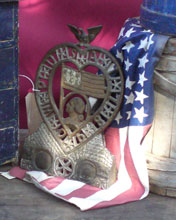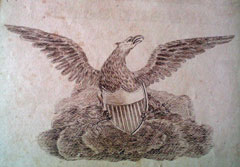|
Birth of the American Eagle
 As we all know, on July 4, 1776, the Continental Congress adopted the Declaration of Independence. On that auspicious day, they also appointed a committee of Franklin, J. Adams and Jefferson to prepare a device for a Seal of the United States of America. This started a six year odyssey including multiple designs and committees before the Continental Congress officially adopted a seal on June 20, 1782. The Seal highlighted an American Eagle with one talon holding an olive branch, the other holding thirteen arrows and in his beak a scroll inscribed with the motto “E. Pluribus Unum.” When the original die was cut for the Seal, the eagle was a bit scrawny with droopy wings (original sketch above.) As we all know, on July 4, 1776, the Continental Congress adopted the Declaration of Independence. On that auspicious day, they also appointed a committee of Franklin, J. Adams and Jefferson to prepare a device for a Seal of the United States of America. This started a six year odyssey including multiple designs and committees before the Continental Congress officially adopted a seal on June 20, 1782. The Seal highlighted an American Eagle with one talon holding an olive branch, the other holding thirteen arrows and in his beak a scroll inscribed with the motto “E. Pluribus Unum.” When the original die was cut for the Seal, the eagle was a bit scrawny with droopy wings (original sketch above.)
Prior to the adoption of the eagle in the Seal, the New World was typically symbolized by a woman – sitting, standing and in different dress over the years. The eagle took time to become popular and indeed for a number of years, lady liberty was often the more prominent image with the eagle playing a supporting role. The first appearance of the Seal in any popular medium was in the Columbian Magazine for September 1786 – and it wasn’t totally accurate.
Another boost to the popularity of the eagle came in 1783 when the “Society of Cincinnati” was formed by the officers of the American Revolution. They adopted a badge with a bald eagle to represent the Society. The publicity that came with the rules, passing membership down through the male line of descent, led to great debate and inadvertently caused the biggest criticism of the eagle from Benjamin Franklin. In a letter to his daughter, he did indeed think the turkey, found only in America and a more respectable bird than an eagle, more appropriate to represent the Society. Although he was commenting on the poor drawing provided by the Society, his general distaste for the eagle remains.
 On April 30, 1789, George Washington took the oath of office as the first President. The eagle became firmly launched during the inauguration and celebrations afterward – from appearing on the buttons of Washington’s suit, to architecture on the building and throughout the celebrations in the States on fans, handkerchiefs, and even on a grand arch in Boston. On April 30, 1789, George Washington took the oath of office as the first President. The eagle became firmly launched during the inauguration and celebrations afterward – from appearing on the buttons of Washington’s suit, to architecture on the building and throughout the celebrations in the States on fans, handkerchiefs, and even on a grand arch in Boston.
Although the general attributes of the Seal were described, it was not a fixed prescribed form. So we see variations of the eagle – from emblematic versions, such as on the Great Seal, to more naturalistic versions, such as on many of our coins. The eagle as the patriotic symbol of the United States firmly became the de-facto standard.
 More than any other symbol, the eagle was used on the widest variety of objects. Carved versions appeared on ships and public and private buildings. Some were created by master carvers such as the Skillin brothers John and Simeon, Jr., Samuel McIntire, and William Rush. John Bellamy, born in 1836, was a prodigious carver producing eagles that have survived and are in many folk art collections. The eagle was heavily adopted by the early military. It appears in paintings, was pressed into metal such as on a stove plate, and decorated stoneware. From England and China, it was added to porcelain and softpaste targeted to the new republic’s growing population. Eagles appeared on paper including papyrotamia (intricate paper cutouts) and on calligraphy. Furniture – in the bedroom and the sitting room featured eagles including the famous Hitchcock chairs. Eagles were included in quilts, samplers and other textiles. Every type of storage—glassware, tinware, boxes—were decorated with eagles. By the first quarter of the 1800s, the eagle was the most popular motif on tavern signs. The eagle became one of the most popular weathervanes. More than any other symbol, the eagle was used on the widest variety of objects. Carved versions appeared on ships and public and private buildings. Some were created by master carvers such as the Skillin brothers John and Simeon, Jr., Samuel McIntire, and William Rush. John Bellamy, born in 1836, was a prodigious carver producing eagles that have survived and are in many folk art collections. The eagle was heavily adopted by the early military. It appears in paintings, was pressed into metal such as on a stove plate, and decorated stoneware. From England and China, it was added to porcelain and softpaste targeted to the new republic’s growing population. Eagles appeared on paper including papyrotamia (intricate paper cutouts) and on calligraphy. Furniture – in the bedroom and the sitting room featured eagles including the famous Hitchcock chairs. Eagles were included in quilts, samplers and other textiles. Every type of storage—glassware, tinware, boxes—were decorated with eagles. By the first quarter of the 1800s, the eagle was the most popular motif on tavern signs. The eagle became one of the most popular weathervanes.
In salute to Independence Day, search for eagle on Dig Antiques and enjoy a wide variety of Americana.
Additional Resources:
The American Eagle, Philip M. Isaacson, New York Graphic Society, Boston, MA, 1975.
Great Seal of the United States, Wikipedia.
The Eagle, Ben Franklin, and the Turkey, GreatSeal.com.
|
|
Celebrate with the 1776 Dig Antiques Sale!
Create your own fireworks this year by checking out the Dig Antiques Sale on Wednesday July 4 from 9am-midnight, Eastern time. The participating Shops will have sale prices that mirror the 1776 theme - anything from $17.76 to $1776, or any combination of those numbers such as $76, $176, $776, etc. Some will deduct $17.76 from the regular low price or give a 17 percent discount.
The following Shops at Dig Antiques will be participating in this one day firecracker of a patriotic sale:
Check back during the sale as items may change - it's up to each individual Shop! Please thank Lyn Andeen, Andeen Antiques, for coming up with this great patriotic idea!
Vermont and New York in July
As you read this we are on our annual drive east. During July, you can find us, along with Dig Antiques tote bags at the following places:
If you stop to visit with us, you will receive a Dig Antiques tote bag at no charge! Just let us know you would like a reuseable bag.
Search for Antiques to find exactly what you are looking for and/or
Open your Own Shop on Dig Antiques!
We hope you have a wonderful July 4th holiday with family and friends.
Sincerely,
Tom & Sheila Baker
diginfo@digantiques.com
We Dig It...do you? Dig Antiques - Real stuff without the fluff.

|

 As we all know, on July 4, 1776, the Continental Congress adopted the Declaration of Independence. On that auspicious day, they also appointed a committee of Franklin, J. Adams and Jefferson to prepare a device for a Seal of the United States of America. This started a six year odyssey including multiple designs and committees before the Continental Congress officially adopted a seal on June 20, 1782. The Seal highlighted an American Eagle with one talon holding an olive branch, the other holding thirteen arrows and in his beak a scroll inscribed with the motto “E. Pluribus Unum.” When the original die was cut for the Seal, the eagle was a bit scrawny with droopy wings (original sketch above.)
As we all know, on July 4, 1776, the Continental Congress adopted the Declaration of Independence. On that auspicious day, they also appointed a committee of Franklin, J. Adams and Jefferson to prepare a device for a Seal of the United States of America. This started a six year odyssey including multiple designs and committees before the Continental Congress officially adopted a seal on June 20, 1782. The Seal highlighted an American Eagle with one talon holding an olive branch, the other holding thirteen arrows and in his beak a scroll inscribed with the motto “E. Pluribus Unum.” When the original die was cut for the Seal, the eagle was a bit scrawny with droopy wings (original sketch above.) On April 30, 1789, George Washington took the oath of office as the first President. The eagle became firmly launched during the inauguration and celebrations afterward – from appearing on the buttons of Washington’s suit, to architecture on the building and throughout the celebrations in the States on fans, handkerchiefs, and even on a grand arch in Boston.
On April 30, 1789, George Washington took the oath of office as the first President. The eagle became firmly launched during the inauguration and celebrations afterward – from appearing on the buttons of Washington’s suit, to architecture on the building and throughout the celebrations in the States on fans, handkerchiefs, and even on a grand arch in Boston. More than any other symbol, the eagle was used on the widest variety of objects. Carved versions appeared on ships and public and private buildings. Some were created by master carvers such as the Skillin brothers John and Simeon, Jr., Samuel McIntire, and William Rush. John Bellamy, born in 1836, was a prodigious carver producing eagles that have survived and are in many folk art collections. The eagle was heavily adopted by the early military. It appears in paintings, was pressed into metal such as on a stove plate, and decorated stoneware. From England and China, it was added to porcelain and softpaste targeted to the new republic’s growing population. Eagles appeared on paper including papyrotamia (intricate paper cutouts) and on calligraphy. Furniture – in the bedroom and the sitting room featured eagles including the famous Hitchcock chairs. Eagles were included in quilts, samplers and other textiles. Every type of storage—glassware, tinware, boxes—were decorated with eagles. By the first quarter of the 1800s, the eagle was the most popular motif on tavern signs. The eagle became one of the most popular weathervanes.
More than any other symbol, the eagle was used on the widest variety of objects. Carved versions appeared on ships and public and private buildings. Some were created by master carvers such as the Skillin brothers John and Simeon, Jr., Samuel McIntire, and William Rush. John Bellamy, born in 1836, was a prodigious carver producing eagles that have survived and are in many folk art collections. The eagle was heavily adopted by the early military. It appears in paintings, was pressed into metal such as on a stove plate, and decorated stoneware. From England and China, it was added to porcelain and softpaste targeted to the new republic’s growing population. Eagles appeared on paper including papyrotamia (intricate paper cutouts) and on calligraphy. Furniture – in the bedroom and the sitting room featured eagles including the famous Hitchcock chairs. Eagles were included in quilts, samplers and other textiles. Every type of storage—glassware, tinware, boxes—were decorated with eagles. By the first quarter of the 1800s, the eagle was the most popular motif on tavern signs. The eagle became one of the most popular weathervanes.